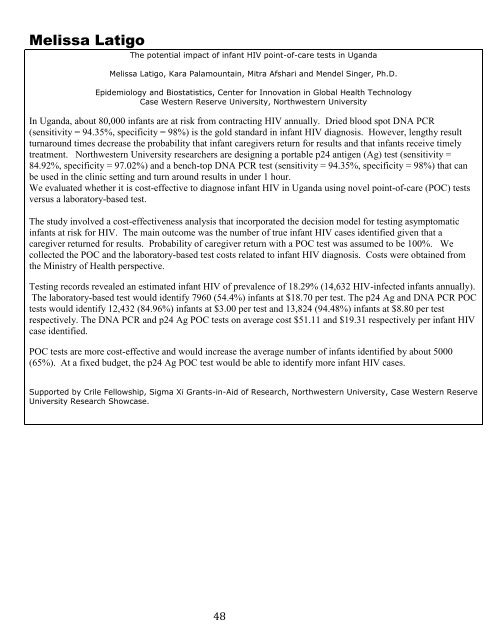student research day - Case Western Reserve University School of ...
student research day - Case Western Reserve University School of ...
student research day - Case Western Reserve University School of ...
You also want an ePaper? Increase the reach of your titles
YUMPU automatically turns print PDFs into web optimized ePapers that Google loves.
Melissa Latigo<br />
The potential impact <strong>of</strong> infant HIV point-<strong>of</strong>-care tests in Uganda<br />
Melissa Latigo, Kara Palamountain, Mitra Afshari and Mendel Singer, Ph.D.<br />
Epidemiology and Biostatistics, Center for Innovation in Global Health Technology<br />
<strong>Case</strong> <strong>Western</strong> <strong>Reserve</strong> <strong>University</strong>, Northwestern <strong>University</strong><br />
In Uganda, about 80,000 infants are at risk from contracting HIV annually. Dried blood spot DNA PCR<br />
(sensitivity = 94.35%, specificity = 98%) is the gold standard in infant HIV diagnosis. However, lengthy result<br />
turnaround times decrease the probability that infant caregivers return for results and that infants receive timely<br />
treatment. Northwestern <strong>University</strong> <strong>research</strong>ers are designing a portable p24 antigen (Ag) test (sensitivity =<br />
84.92%, specificity = 97.02%) and a bench-top DNA PCR test (sensitivity = 94.35%, specificity = 98%) that can<br />
be used in the clinic setting and turn around results in under 1 hour.<br />
We evaluated whether it is cost-effective to diagnose infant HIV in Uganda using novel point-<strong>of</strong>-care (POC) tests<br />
versus a laboratory-based test.<br />
The study involved a cost-effectiveness analysis that incorporated the decision model for testing asymptomatic<br />
infants at risk for HIV. The main outcome was the number <strong>of</strong> true infant HIV cases identified given that a<br />
caregiver returned for results. Probability <strong>of</strong> caregiver return with a POC test was assumed to be 100%. We<br />
collected the POC and the laboratory-based test costs related to infant HIV diagnosis. Costs were obtained from<br />
the Ministry <strong>of</strong> Health perspective.<br />
Testing records revealed an estimated infant HIV <strong>of</strong> prevalence <strong>of</strong> 18.29% (14,632 HIV-infected infants annually).<br />
The laboratory-based test would identify 7960 (54.4%) infants at $18.70 per test. The p24 Ag and DNA PCR POC<br />
tests would identify 12,432 (84.96%) infants at $3.00 per test and 13,824 (94.48%) infants at $8.80 per test<br />
respectively. The DNA PCR and p24 Ag POC tests on average cost $51.11 and $19.31 respectively per infant HIV<br />
case identified.<br />
POC tests are more cost-effective and would increase the average number <strong>of</strong> infants identified by about 5000<br />
(65%). At a fixed budget, the p24 Ag POC test would be able to identify more infant HIV cases.<br />
Supported by Crile Fellowship, Sigma Xi Grants-in-Aid <strong>of</strong> Research, Northwestern <strong>University</strong>, <strong>Case</strong> <strong>Western</strong> <strong>Reserve</strong><br />
<strong>University</strong> Research Showcase.<br />
48
















